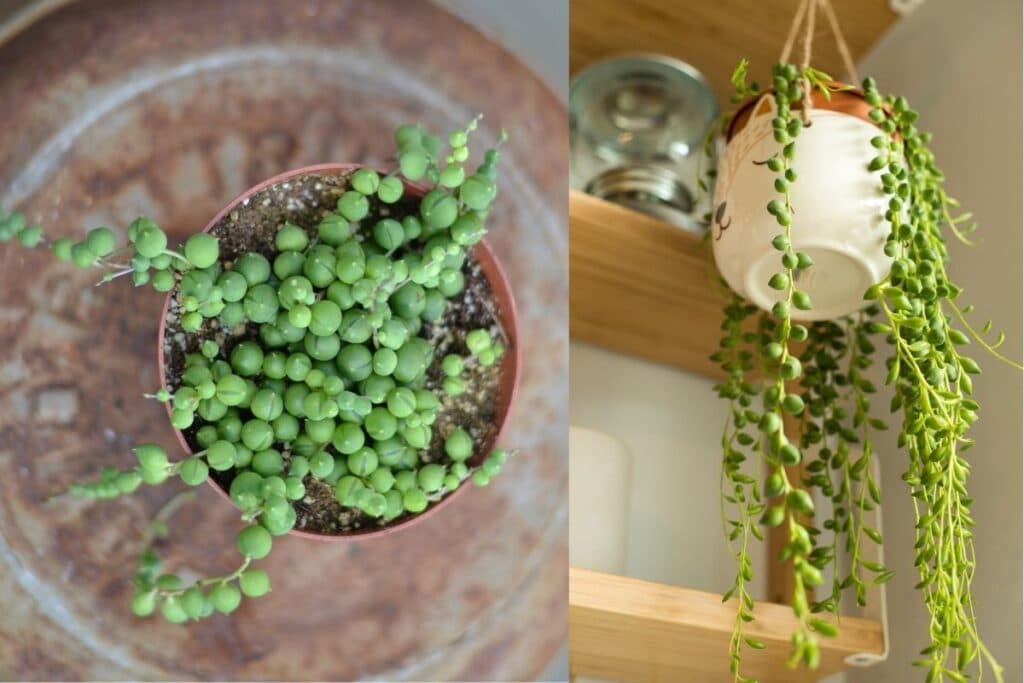Are you looking into different ways of hanging your cacti and succulents, or you would like to set a popular trend in your neighborhood, or you are wondering about the best types of plants you can hang or trail?
- Basic Differences Between Cacti and Succulents
- Types of Trailing and Hanging Cacti and Succulent You Can Grow
- #1. Euphorbia tirucalli, ‘’Sticks on fire’’
- #2. Agave attenuata ‘’Fox Tail Agave’’
- #3. Aporocactus Flagelliformis, ‘‘Rat Tail Cactus’’
- #4. Beaucarnea recurvata, ‘’Ponytail Palm’’
- #5. Ceropegia Linearis Woodii, ‘’String of Hearts or Rosary Vine’’
- #6. Crassula Pellucida Variegata, ‘‘Calico Kitten’’
- #7. Epiphyllum anguliger, ‘’Fishbone Cactus’’
- #8. Othonna capensis, ‘‘Ruby Necklace’’
- #9. Senecio radicans, ‘’String of Bananas’’
- #10. Calandrinia spectabilis ‘’Rock Purslane’’
- #11. Senecio rowleyanus, ‘’String of Pearls’’
- #12. Senecio Fish Hooks, “Grey Fishhooks Senecio’’
- #13. Euphorbia caput-medusae, ‘’Medusa Head’’
- #14. Dischidia nummularia, ‘‘Strings of Nickels’’
- #15. Sedum morganianum, ‘‘Donkey’s Tail’’
- #16. Sedum burrito, ‘‘Baby Donkey Tail’’
- #17. Hoya Plant, ‘Wax Plant’
- #18. Senecio herreianus, ‘‘String of Beads’’
- #19. Hildewintera Colademononis, ‘‘Monkey’s Tail’’
- #20. Echinopsis Chamaecereus, ‘‘Peanut Cactus’’
- #21. Sedum Little Missy, ‘‘Sedum Petite Bicolor’’
- #22. Euphorbia milii, ‘’Crown of Thorns’’
- #23. Schlumbergera x buckleyi, ‘’Christmas Cactus’’
- #24. Kalanchoe blossfeldiana, ‘’Flowering Kalanchoe’’
- #25. Echeveria, ‘‘Afterglow’’
- #26. Sansevieria trifasciata, ‘’Snake Plant’’
- #27. Euphorbia tithymaloides, ‘’Devil’s Backbone’’
- #28. Kalanchoe tomentosa, ‘’Panda Plant’’
- #29. Gymnocalycium mihanovichii, ‘’Chin Cactus’’
- #30. Euphorbia trigona, ‘’African Milk Tree Cactus’’
- #31. Opuntia microdasys, ‘’Angel Wings Cactus’’
- #32. Mammillaria hahniana, ‘’Old Lady Cactus’’
- FAQs
Hanging succulents are a beautiful and sophisticated way that will help you transform your garden and even your indoor area!
Here you will learn more about how to hang succulents easily or how to trail cacti, and, most importantly, you will know how to successfully take care of all the plants you have, even if you are a very busy person!
Here you will learn about the Echinopsis Chamaecereus Cactus ‘’Peanut Cactus’’, the Dischidia nummularia ‘’Strings of Nickels’’, and the Othonna capensis ‘Ruby necklace’’, just to name a few.
Continue reading and discover this wonderful world filled with cacti and succulent plants hanging or trailing in your house!
Basic Differences Between Cacti and Succulents
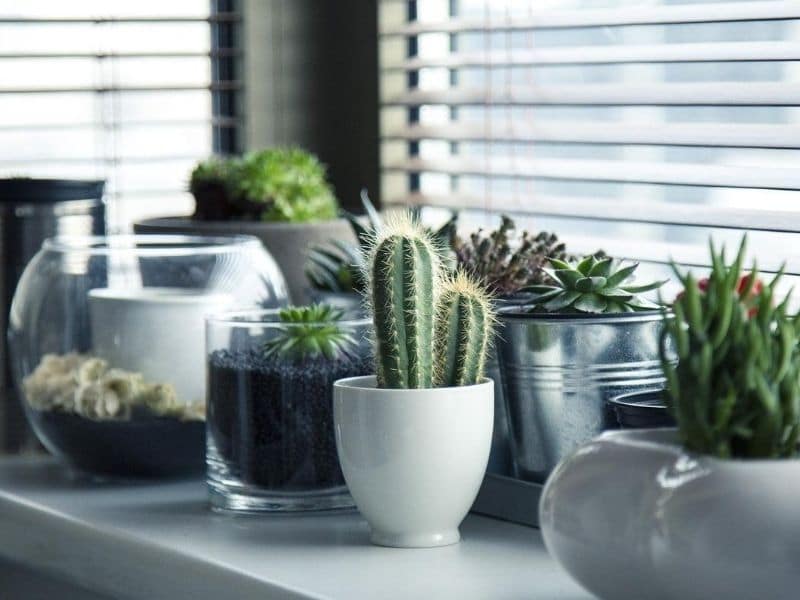
One of the most straightforward descriptions between cactus and succulents is that all cacti are succulents; however, not all succulents are cacti. This is because succulents come from various plant families, whereas cacti are all closely related within the Cactaceae plant family.
Moreover, if you are not too sure whether your plant is a cactus or a succulent, then you can follow one rule that will tell you most of the time what type of plant you are looking at:
If your plant has areolas (which are the small, rounded, and usually colored bumps you can easily spot on the surface of the plant and where you can also see the spines and the flowers grow), you have a cactus.
In other words, if it has an areola, then you are looking at a cactus. If it doesn’t have the areolas, then it can be a succulent plant.

Types of Trailing and Hanging Cacti and Succulent You Can Grow
The following are the most beautiful and popular hanging cacti and succulent plants that you can hang or trail in your garden or indoor area:
#1. Euphorbia tirucalli, ‘’Sticks on fire’’
Don’t let this name scare you! These cacti have a toxic sap, so put them away from children and pets. You can easily grow them indoors or outdoors. Its stems can grow up to 3 feet long and tend to turn bright red and yellow, which makes it look as if it’s on fire.
They are ideal for growing in hanging baskets as the stems need space to spread out.
#2. Agave attenuata ‘’Fox Tail Agave’’
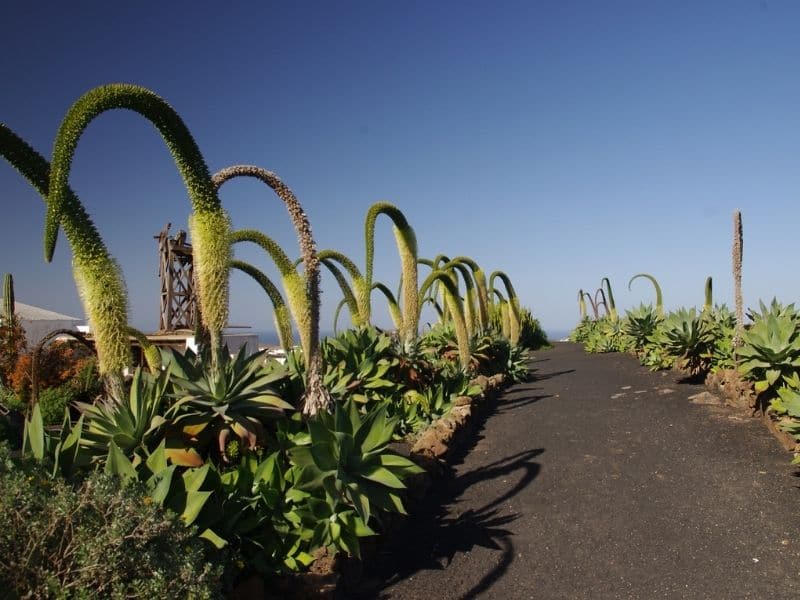
Everyone loves this succulent! They have unique inflorescences that bend over and give the succulent an interesting looking aspect.
Colloquially known as the ‘’Fox Tail Agave’’, this succulent is native to Mexico, and they prefer dry climates in order to thrive. They are often used as an ornamental plant in many areas of the world.
#3. Aporocactus Flagelliformis, ‘‘Rat Tail Cactus’’
This cactus is native to Mexico, and you can quickly grow it indoors or outdoors. However, they do produce very long stems, so you will need to keep this in mind if you are going to hang them.
However, they tend to prefer growing in hanging baskets because this will allow their stem to spread easily!
Make sure you wear gloves when you are about to handle this cactus, as they have fragile spines that can be a problem if you are working with the cactus barehanded.
This cactus can flower; so, it is normal to see pink and red flowers when the cactus is more mature. If you have a rat tail cactus plant make sure the soil is completely dried before watering it.
If you are looking into propagating cactus, then do so from a stem, which will be easier to replicate than growing them using seeds.
#4. Beaucarnea recurvata, ‘’Ponytail Palm’’
This succulent is also colloquially known as ‘’elephant’s foot palm’’ thanks to its thick trunk. It has thin and long leaves, and it tends to grow so slow that you won’t even need to repot it for at least a couple of years.
#5. Ceropegia Linearis Woodii, ‘’String of Hearts or Rosary Vine’’

Native to South Africa, String of Hearts plant will look fantastic if you hang it or trail it mainly due to its distinctive flowers that have heart-shaped leaves.
They have green stems, which sometimes can go from a pale tone to a very dark tone. They prefer being exposed to light; however, this light cannot be directly pointing at them.
They require a lot of water throughout the summer, but when winter comes, you can drastically reduce this amount. If you are hanging this plant, you will need to place them high enough, so they have enough room for the vines to grow.
#6. Crassula Pellucida Variegata, ‘‘Calico Kitten’’
This succulent plant also has heart-shaped leaves, making it an excellent choice for hanging baskets indoors and outdoors. Even though its leaves are green, they have a pink and cream tint, which makes them even more special.
You can place them directly under the sunlight, and this will bring about its colors. They will not, however, survive hard frosts or intense winters.
You should not water them regularly; on the contrary, you should only water them once a week or so, and the container they are in must have drainage holes that are big enough for water to come out; this way, you will avoid root rot.
#7. Epiphyllum anguliger, ‘’Fishbone Cactus’’
This type of epiphyllum is native to Mexico, so it needs to grow in warm climates where there is full exposure to the sun. It is usually grown as an ornamental plant.
The thick fleshy stems tend to trail when they are young, but when they reach maturity, they become too long to continue. What’s interesting about this cactus is that they produce nocturnal flowers; in other words, you will only be able to see them at nighttime.
They also produce fruit, which is usually yellow and has a strong scent.
#8. Othonna capensis, ‘‘Ruby Necklace’’
This is a very interesting looking succulent that has many different vibrant colors! They have blue-green leaves, and they also produce flowers which are yellow or orange!
Can you imagine them hanging indoors or outdoors in your house? Simply beautiful!
Unlike other succulents on this list, the Ruby necklace can tolerate full exposure to direct sunlight. They only need well-drained soil to thrive.
#9. Senecio radicans, ‘’String of Bananas’’
This plant is native to South Africa. It is a beautiful succulent plant, and you can grow it in hanging planters, which will, in turn, allow the stems to grow in different directions.
It would be best if you placed them in a roomy area, as the stems can grow up to 35 inches in length. As its name suggests, the stems (or better yet, the leaves found in the stems) look like bananas.
This lovely succulent has an overpowering scent, and it produces yellow lavender or white flowers.
However, this is a very toxic succulent, especially for cats, as it can be poisonous.
#10. Calandrinia spectabilis ‘’Rock Purslane’’
This is a perennial succulent native to Chile. They produce small purple or pink flowers, which are loved by pollinators such as bees, hummingbirds, and butterflies. They usually grow up to eight inches tall; so, they are tiny succulents.
If you are planting them, make sure you do so when the extreme danger of frosts has passed by, as they are very susceptible to cold weather.
#11. Senecio rowleyanus, ‘’String of Pearls’’
String of Pearls plant is native to South Africa. You can grow it as a hanging succulent, and it will look fantastic in any area! Its stems have green leaves, and they resemble peas.
The leaves can grow up to 35 inches in length, and they will grow all over the place!
If you live in an area where frosts are the norm, consider growing this plant indoors, as they will not tolerate strong cold climates.
You can easily propagate this plant by using a cutting; just plant the cutting where you would like, and make sure you water it every other day. Place them in an area where they receive indirect sunlight, and you will soon see how they thrive and grow.
See more: String of Dolphins Plant
#12. Senecio Fish Hooks, “Grey Fishhooks Senecio’’
Its shape is so unique that it has given this plant its name as well! The leaves look like fish hooks! They can have very long stems that could easily reach more than 5 inches long.
This is a trailing succulent, but it is so easy to care for and to propagate that you will be wondering if it’s a real succulent or not!
Make sure you don’t place them under direct sunlight; otherwise, their leaves could burn. As with many other types of succulents, you will need to water them every couple of days. When you water them, use a lot of water, but let the soil dry out thoroughly before you water them again.
#13. Euphorbia caput-medusae, ‘’Medusa Head’’
This succulent plant resembles a snake! Its stems are very short and cylindrical, and they can grow up to 11 inches in length. The stems have small green leaves. They tend to bloom once they reach maturity.
Unlike any other succulent, you will need to water it regularly; otherwise, they will suffer from droughts, especially during the summer months.
#14. Dischidia nummularia, ‘‘Strings of Nickels’’
One of the most exciting plants to look at! They are native to tropical rainforests, which means they can be found in many places as well.
They are epiphyte plants, so if you allow them to grow in nature without intervening, they will grow on top of tree trunks, rocks, and even other plants! They surely don’t know anything about personal space, hey!?
Once they reach maturity, they will start producing white and cream blooms, which look lovely if you hang them!
The Dischidia plants need quite a bit of maintenance, mainly because of the epiphyte characteristic I mentioned earlier. They require well-drained soil, which will allow them to thrive.
You will also need to place them in a very humid place, as they need lots of water and the right atmosphere that gives them the impression they are still growing in a tropical rainforest.
Learn more about Dischidia varieties and types to grow!
#15. Sedum morganianum, ‘‘Donkey’s Tail’’
Colloquially known as the Burro’s tail, they are native to Mexico. They are hanging succulent plants that produce pointy green leaves that are very long and vibrant.
Its stems grow in such a particular way that they resemble the donkey’s tail; hence the name of this succulent.
This species is drought tolerant plant, so you shouldn’t worry if you ever forget to water them. However, you should water the soil only when it’s completely dried and wait for a couple of days (or even weeks) before watering them again.
They need to receive indirect sunlight if you would like to see them thrive; they are a perfect type of succulent to hang in baskets or containers.
#16. Sedum burrito, ‘‘Baby Donkey Tail’’
Not to be confused with the other type of succulent called ‘’ donkey’s tail’’. They are also native to Mexico. This succulent has smaller and more dense leaves in comparison to the Donkey tail succulent.
They are relatively easy to grow: you need to make sure they have well-drained soil and receive indirect sunlight. If you live in a hot climate, you will need to water them regularly throughout the summer. They are often placed in hanging baskets and are used as ornamental plants or as a way to make a wall display.
#17. Hoya Plant, ‘Wax Plant’
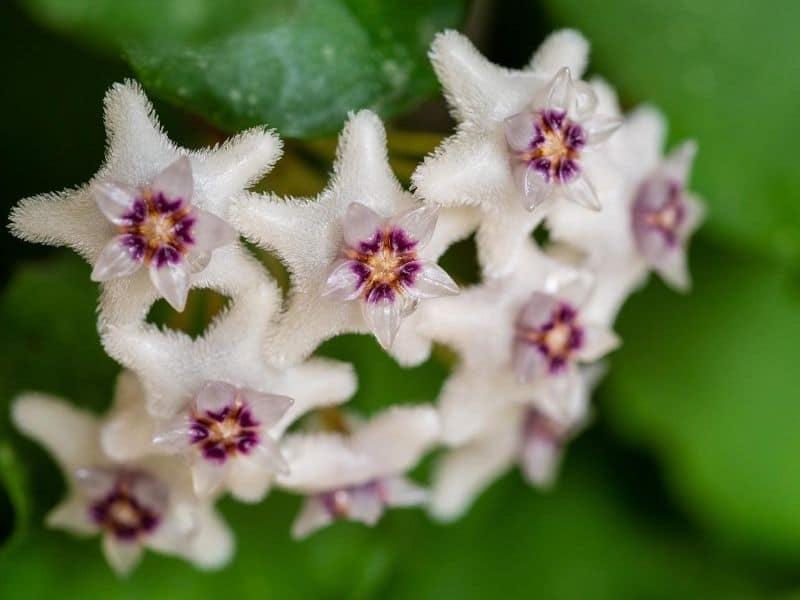
Also referred to as the ‘’Hindu Rope’’; this plant is native to Australia, India, and many other countries within Asia. It has vines that produce beautiful heart-shaped leaves, and even though they are hard to find in some countries, they still look beautiful whenever they are hanged.
They need to be in partial shade as they cannot tolerate full exposure to the sun. You could grow them indoors or outdoors, and you can use hanging baskets that will allow the stems to hang over all of the edges. In comparison to other plants, the Hoya succulent needs humidity to thrive.
#18. Senecio herreianus, ‘‘String of Beads’’
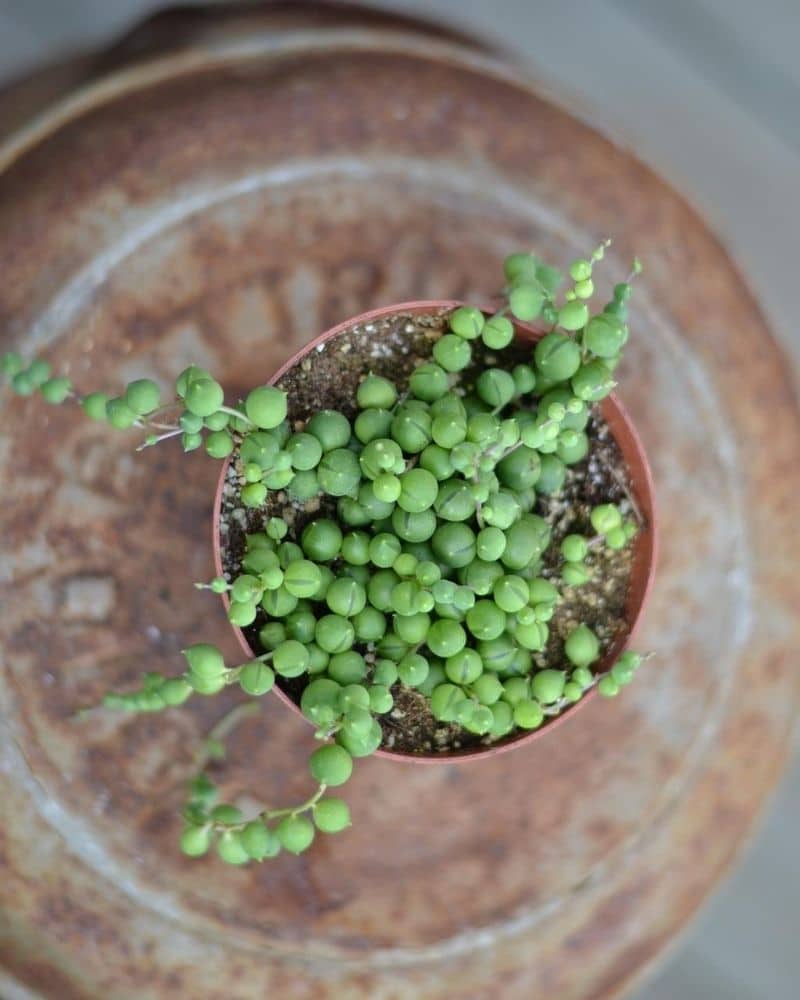
This plant is native to South Africa. It’s a succulent plant that you can easily hang or trail. They are not very common, and they are usually mistaken for ‘String of Pearls’ due to their similarity. However, the ‘String of Beads’ has oval-shaped leaves.
They are reasonably easy to propagate, you just need to make sure your soil is right so they can root correctly. If you live in an area with cold winters, make sure you protect your plant against extreme climate or frosts as they won’t survive otherwise.
#19. Hildewintera Colademononis, ‘‘Monkey’s Tail’’
Native to Bolivia, this cactus has an epilithic property, which means it only grows on rocks. How interesting is this!? They also have light green stems, which are sometimes fully covered with hairy spines, so you will need to use gloves whenever you handle them.
They can be fully exposed to the sun, as these hairy spines will protect the plant from any extreme climate condition. Lastly, place them in a hanging basket, and once your plant matures, you will see its blooms, which are usually red or magenta. It is a wonderful sight!
#20. Echinopsis Chamaecereus, ‘‘Peanut Cactus’’
One of my favorite plants, this cactus is native to Argentina! They have very long stems that resemble our fingers. On each one of those stems, they also produce soft white spines, so watch out whenever you handle the cactus!
When the peanut cactus matures, you will see some orange or red flowers, which are very beautiful!
You don’t need to water them regularly, as they resist extreme weather conditions. However, their soil must be well-drained, otherwise, they will get root rot.
#21. Sedum Little Missy, ‘‘Sedum Petite Bicolor’’
As its name suggests, this perennial succulent has two colors: pale green and pink, which surrounds its margins. Each summer, Little Missy succulents will produce pink and white flowers that look gorgeous in a hanging basket or trail.
You do not need to do much to maintain them; in fact, they are so easy to grow that you could even plant them wherever you are struggling to grow other things. This type of plant is the savor one because they will thrive everywhere!
#22. Euphorbia milii, ‘’Crown of Thorns’’

This is an evergreen succulent plant, so it has bright flowers that never fade away. You will need a lot of available space if you want to grow them, though, as they can reach up to three feet if you let them!
They also need to be guarded against cold climates; but, make sure no children or pets are near it, as they are moderately toxic. If you handle this plant, use some gloves!
#23. Schlumbergera x buckleyi, ‘’Christmas Cactus’’

This is your perfect Christmas plant. In fact, it could also be the ultimate Christmas present for all of your friends and family members! This cactus produces some red, pink, orange, and even purple flowers.
They should not be placed directly under sunlight; otherwise, they will stop growing.
#24. Kalanchoe blossfeldiana, ‘’Flowering Kalanchoe’’
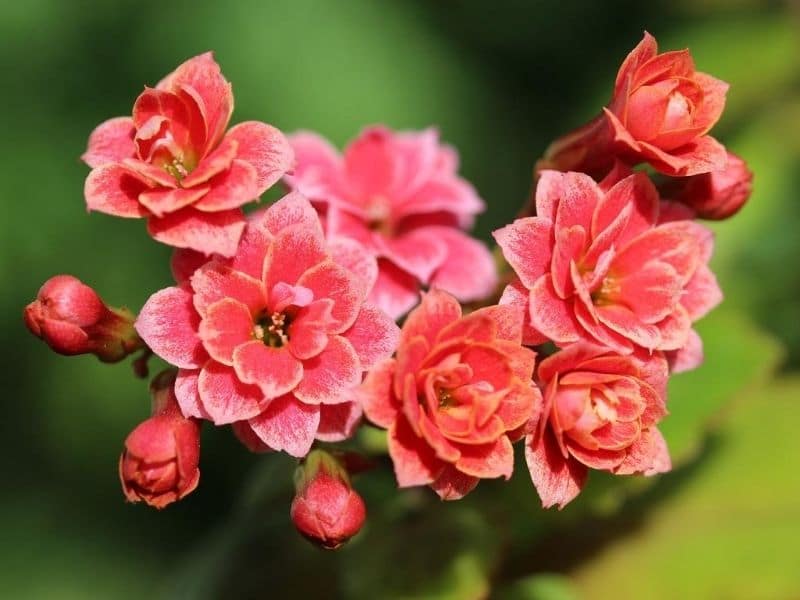
If you want to have trailing succulents that catch everyone’s attention, then look no further because the Kalanchoe blossfeldiana will be your perfect choice. They are also called flowering kalanchoe for a reason!
They have orange, pink, cream, yellow, white, red, and purple flowers and very dark and oval foliage, which makes an exciting and sharp contrast.
They cannot be compared to any other succulent—they are simply astonishing!
#25. Echeveria, ‘‘Afterglow’’
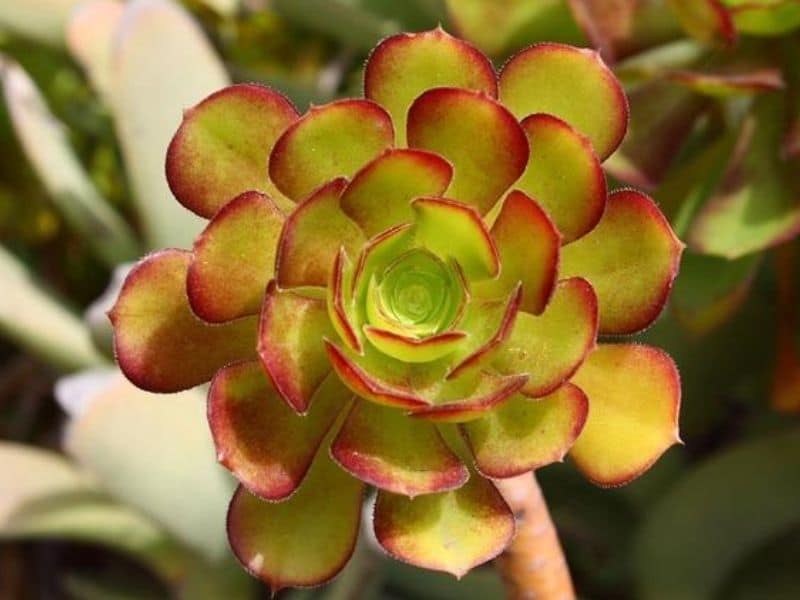
This succulent also produces orange or red flowers. They will look fantastic in any hanging basket because you could even place them and form a rosette type of bouquet. They have lavender leaves that will grow and hang out of the basket.
You should definitely consider growing this rosette succulent!
#26. Sansevieria trifasciata, ‘’Snake Plant’’
Everybody loves snake plants! They are so easy to maintain that they are shade and drought tolerant, and, the most crucial aspect is that they do not come with snakes! They are the perfect succulent to hang in a basket, especially if you always forget about watering your plants.
#27. Euphorbia tithymaloides, ‘’Devil’s Backbone’’
Don’t let the long name fool you—this succulent is lush! It can tolerate strong climates. You do need to place it in a very open space because it can grow up to 8 feet tall. However, Devil’s Backbone plant is another highly toxic plant, so no one should be touching without any gloves or the right equipment.
#28. Kalanchoe tomentosa, ‘’Panda Plant’’

This succulent is so cute that you will want to have them all over the place! They have thin white ‘’hairs’’ called trichomes, which cover all of the pale green leaves.
They are called Panda plants because they have brownish spots, which make them look like pandas!
#29. Gymnocalycium mihanovichii, ‘’Chin Cactus’’
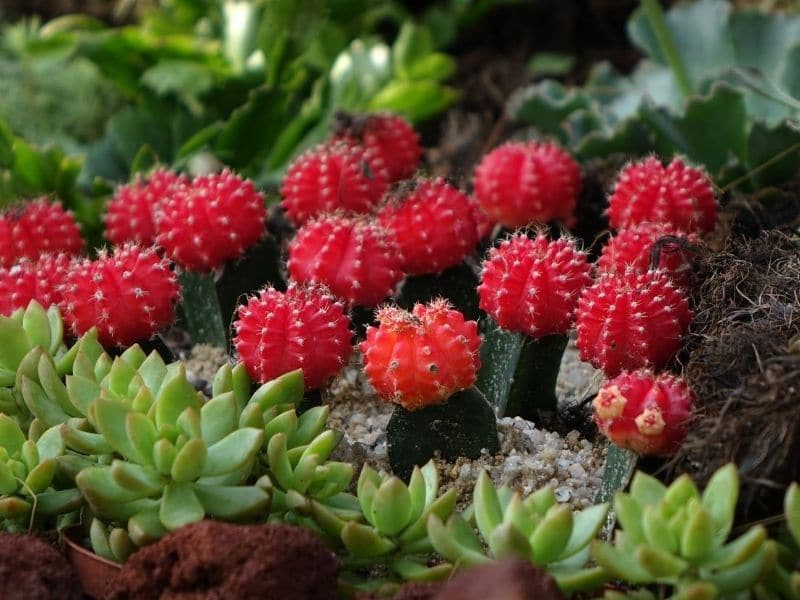
This cactus has fascinating colors: its leaves have a pink tone to them. They also bloom, and its flowers are white, pink cream, or even green! They do well when exposed to direct sunlight; however, they require lots of water in order to thrive.
#30. Euphorbia trigona, ‘’African Milk Tree Cactus’’
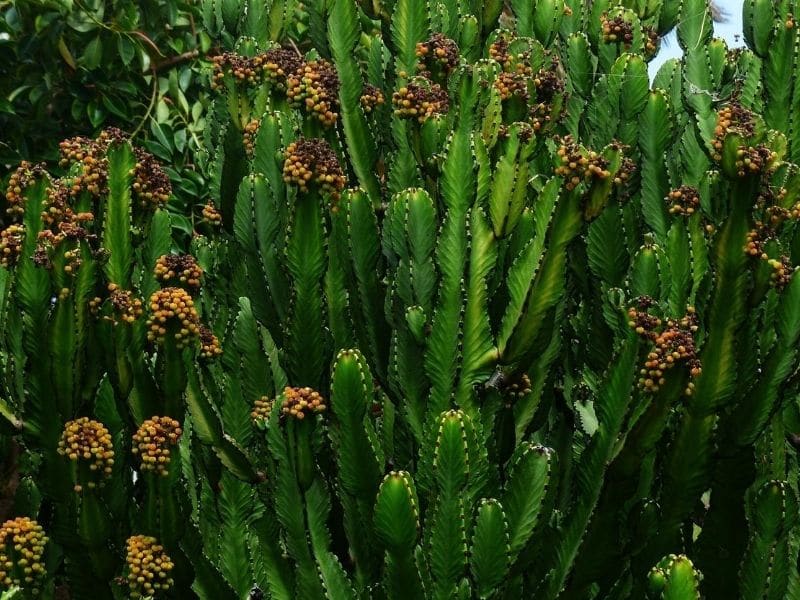
This is one of the slowest growing succulent ever! And even though they are fairly easy to grow, they will take their own time to do so. They can grow up to eight feet in height and need to be constantly watered.
#31. Opuntia microdasys, ‘’Angel Wings Cactus’’
They resemble some bunny ears! It has yellow and cream flowers that only bloom during the summer. These flowers will then turn into red or purple fruits. They are lovely, and you can quickly grow them in a hanging basket.
#32. Mammillaria hahniana, ‘’Old Lady Cactus’’
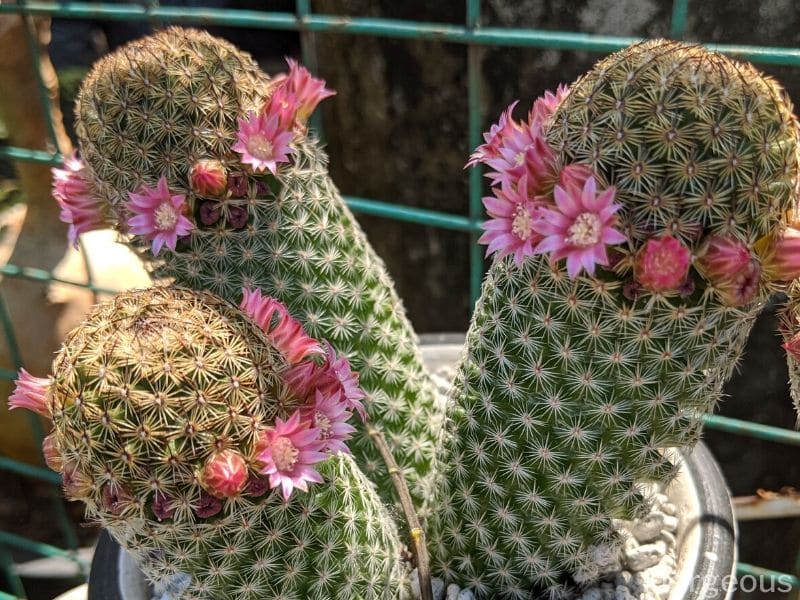
Its funny name matches its appearance! This cactus has white hair that covers the whole cactus. They will bloom in pink flowers, which are also strange looking as they protrude from the plant’s head.
FAQs
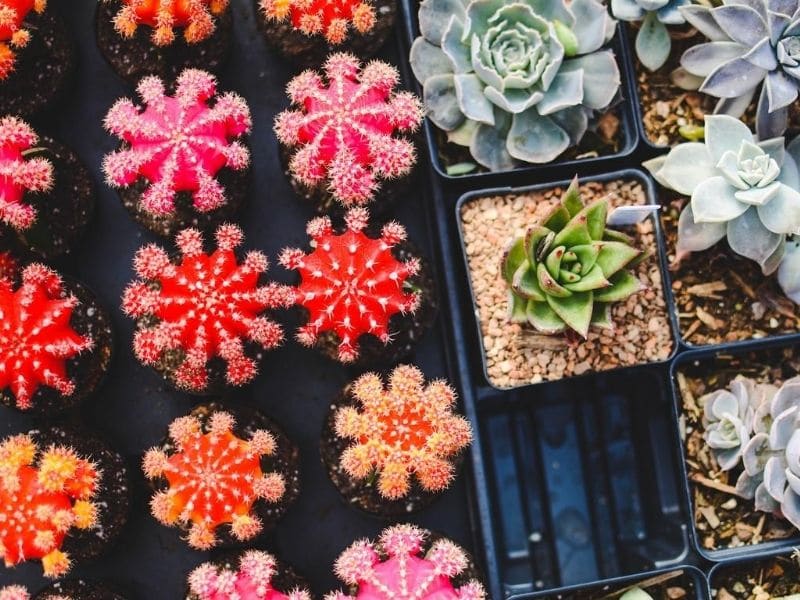
Here are some frequently asked questions about cacti and succulents that you could hang or trail:
What are hanging succulents called?
Hanging succulents are often referred to as “trailing” or “cascading” succulents. Some popular varieties include String of Pearls (Senecio rowleyanus), String of Bananas (Senecio radicans), and Donkey’s Tail (Sedum morganianum).
Do hanging succulents need sun?
Hanging succulents typically prefer bright indirect light. While they can tolerate some direct sunlight, especially in the morning or late afternoon, too much intense sun can cause sunburn or leaf damage.
How often do you water hanging succulents?
Water hanging succulents when the top inch of soil feels dry to the touch. Allow the soil to dry out between waterings to prevent overwatering, as succulents are prone to rot if kept too wet.
What is a long thin hanging succulent?
One example of a long, thin hanging succulent is String of Bananas (Senecio radicans). This trailing succulent features slender, banana-shaped leaves cascading from stems, making it an attractive addition to hanging baskets.
Do succulents grow well in hanging baskets?
Yes, many succulents grow well in hanging baskets, especially trailing or cascading varieties. Planting succulents in hanging baskets allows their stems to drape gracefully over the edges, creating a visually appealing display.
Conclusion
As you can see, if you hang or trail your succulents and your cacti, then you could easily put them both indoors or outdoors. You will also bring a lot of character to your home because these plants tend to catch everyone’s attention!
If you do end up doing a garden makeover and decide to put these plants in trails or hang them, you will not regret it, and you could even become a very popular gardener because you have decided to present your plants this way!
See more: How to care for succulents
Photo by depositphotos.com/silviacozzi

